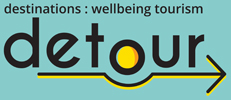-
Module 1: Introduction to Wellness and Wellness Tourism
8-
Introduction to Module 1Module1.1
-
1.1 WellnessModule1.2
-
1.2 TourismModule1.3
-
1.3 DestinationModule1.4
-
1.4 SustainabilityModule1.5
-
1.5 Case studyModule1.6
-
SummaryModule1.7
-
Module 1 QuizModule1.8
-
-
Module 2: Wellbeing in a New Era
7-
Introduction to Module 2Module2.1
-
2.1 Wellbeing & Travel TrendsModule2.2
-
2.2 Happiness and WellbeingModule2.3
-
2.3 Welcoming VisitorsModule2.4
-
2.4 Digging DeeperModule2.5
-
SummaryModule2.6
-
Module 2 QuizModule2.7
-
-
Module 3: The Experience Economy
8-
Introduction to Module 3Module3.1
-
3.1 The Value of ExperiencesModule3.2
-
3.2 Four Realms of ExperienceModule3.3
-
3.3 Experience Design PrinciplesModule3.4
-
3.4 Going Beyond the ExperienceModule3.5
-
3.5 Digging DeeperModule3.6
-
SummaryModule3.7
-
Module 3 QuizModule3.8
-
-
Module 4: Engineering Wellbeing Experiences
9-
Introduction to Module 4Module4.1
-
4.1 The Need to EscapeModule4.2
-
4.2 The Optimal ExperienceModule4.3
-
4.3 LiminalityModule4.4
-
4.4 StorytellingModule4.5
-
4.5 MindfulnessModule4.6
-
4.6 Digging DeeperModule4.7
-
SummaryModule4.8
-
Module 4 QuizModule4.9
-
-
Module 5: Customer Journey Mapping
6-
Introduction to Module 5Module5.1
-
5.1 Customer Journey MapsModule5.2
-
5.2 CJM in PracticeModule5.3
-
5.3 Digging DeeperModule5.4
-
SummaryModule5.5
-
Module 5 QuizModule5.6
-
-
Module 6: Storytelling in Culinary Tourism
8-
Introduction to Module 6Module6.1
-
6.1 Culinary TourismModule6.2
-
6.2 Wellness cuisineModule6.3
-
6.3 How to Detect Wellness Cuisine in a Destination?Module6.4
-
6.4 Providing a Good Food StoryModule6.5
-
6.5 Digging DeeperModule6.6
-
SummaryModule6.7
-
Module 6 QuizModule6.8
-
-
Module 7: Setting up a Wellbeing Business
9-
Introduction to Module 7Module7.1
-
7.1 How to Become an EntrepreneurModule7.2
-
7.2 Challenges of Setting-up Your Own BusinessModule7.3
-
7.3 How to Start your own businessModule7.4
-
7.4 Looking for Additional Ideas to Create Your Own Business Model?Module7.5
-
7.5 Digging DeeperModule7.6
-
7.6 Digging DeeperModule7.7
-
SummaryModule7.8
-
Module 7 QuizModule7.9
-
-
Module 8: Branding for Wellbeing
6-
Introduction to Module 8Module8.1
-
8.2. Brands Identity and PersonalityModule8.2
-
8.3. Brand Visual IdentityModule8.3
-
8.4. Digging DeeperModule8.4
-
SummaryModule8.5
-
Module 8 QuizModule8.6
-
-
Module 9: Digital Marketing
6-
Introduction to Module 9Module9.1
-
9.1. Digital Marketing StrategyModule9.2
-
9.2. Digital Marketing ToolsModule9.3
-
9.3 Digging DeeperModule9.4
-
SummaryModule9.5
-
Module 9 QuizModule9.6
-
-
Additional Resources
7-
Scotland MapModule10.1
-
Ireland MapModule10.2
-
Iceland MapModule10.3
-
Azores MapModule10.4
-
Slovenia MapModule10.5
-
Create your own mapModule10.6
-
PodcastsModule10.7
-
Iceland Map
Iceland
Iceland is a 103,000 km2 volcanic island in the North Atlantic Ocean lying on the constantly active geologic border between North America and Europe.
Iceland’s climate is subpolar oceanic with winters that are milder than most places of similar latitude, thanks to the offshore Gulf Stream. Iceland is a land of vivid contrasts of climate, geography, and culture and is often referred to as a land of fire and ice. Over 10 percent of Iceland’s territory is covered by glaciers, which includes Vatnajökull, the largest glacier in Europe.
Due to the volcanic origin of the island, the country’s natural features include gushing geysers, natural hot springs, as well as lava fields and volcanic deserts creating a unique chance to experience the untouched vastness. All these natural wonders can be found in the South of Iceland, you can also see black beaches, waterfalls, mountainous agricultural areas and glaciers. All these wonders are very easily accessible in the South of Iceland. Icelandic nature has remained quite unspoiled as the island has the lowest population density in Europe of 3.5 people per square kilometre in 2021.
The South is also rich in history and culture. Events from the Medieval Icelandic Sagas are remembered in many ways along the coast of Iceland, several museums in the area celebrate Icelandic customs and heritage. With much of the country’s agricultural products coming from the area, the South is also a fine testimony to Icelandic food and restaurant culture.
Iceland was permanently settled in the late 9th century. The settlers were primarily Norse seafarers and adventurers, and people from the Viking settlements around the British Isles.
Iceland is an ideal place for wellbeing tourism opportunities with all its space and diverse, clean nature.
Find out more from our Detour digital map:
